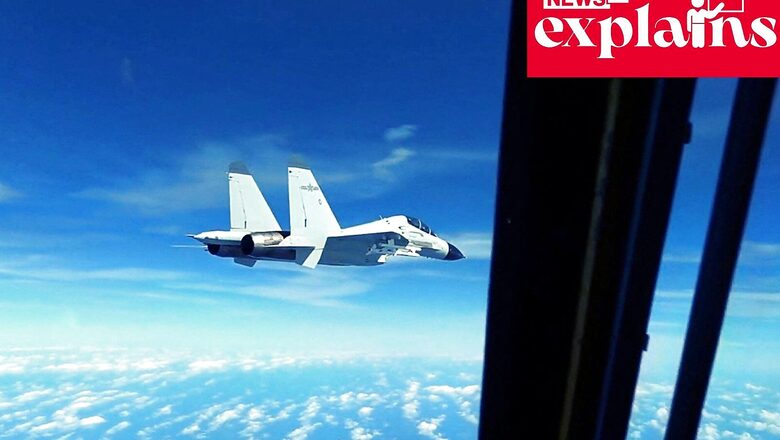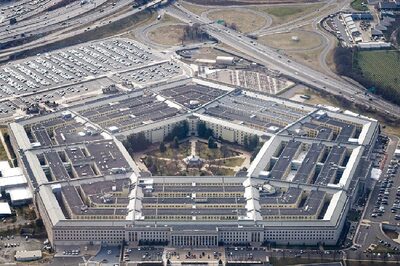
views
Last week, a Chinese military plane came within 10ft (three metres) of a US air force plane over the contested South China Sea, forcing it to perform evasive manoeuvres to avoid a collision in international airspace, according to the US military.
The close encounter was the result of what the United States described as a recent trend of increasingly dangerous behaviour by Chinese military aircraft.
The incident, which involved a Chinese navy J-11 fighter jet and a US air force RC-135 aircraft, occurred on December 21, according to the US military.
“All countries in the Indo-Pacific region are expected to use international airspace safely and in accordance with international law,” it added.
What Happened?
A US military spokesperson told Reuters that the Chinese jet came within 10 feet of the plane’s wing but 20 feet of its nose, causing the US plane to perform evasive manoeuvres.
According to another US official, the US has raised the issue with the Chinese government.
China has previously stated that the United States sending ships and aircraft into the South China Sea is not conducive to peace.
US military planes and ships routinely conduct surveillance and transit through the region.
China claims vast swaths of the South China Sea that overlap with Vietnam, Malaysia, Brunei, Indonesia, and the Philippines’ exclusive economic zones.
Trillions of dollars in trade pass through the waterway each year, which is also home to rich fishing grounds and gas fields.
In a November meeting with his Chinese counterpart, US Defense Secretary Lloyd Austin emphasised the importance of improving crisis communications, as well as what he called dangerous behaviour by Chinese military aircraft.
Despite US-China tensions, US military officials have long sought to maintain open lines of communication with their Chinese counterparts in order to reduce the risk of potential flare-ups or deal with any accidents.
According to Australia’s defence department, a Chinese fighter plane dangerously intercepted an Australian military surveillance plane in the South China Sea region in May.
Australia said the Chinese jet flew close to the Royal Australian Air Force aircraft and released a “bundle of chaff” containing small pieces of aluminium that were ingested into the engine of the Australian aircraft.
In June, Canada’s military accused Chinese warplanes of harassing its patrol planes while monitoring North Korean sanction evasions, forcing Canadian planes to divert from their flight paths.
Strained US-China Ties
Relations between China and the United States have been strained, with disagreements ranging from Taiwan and China’s human rights record to its military activity in the South China Sea.
The visit of US House Speaker Nancy Pelosi to Taiwan in August infuriated China, which saw it as an attempt by the US to meddle in its internal affairs. China then conducted military drills near the island.
Although the United States does not have formal diplomatic relations with Taiwan, it is required by law to provide the island with the means to defend itself.
What is the South China Sea Dispute?
In recent years, the sea has become a flashpoint for tensions between China and other nations claiming sovereignty over two largely uninhabited island chains, the Paracels and the Spratlys.
China claims the majority of the territory, claiming centuries of rights.
The US has long been critical of China’s militarization of the region, and it frequently irritates Beijing with “freedom of navigation” missions.
A BBC team flew over the disputed South China Sea islands in a US military plane in August 2018. The pilots were advised to leave the area “immediately” in order to “avoid any misunderstanding” via radio communication.
In the area, there are dozens of rocky outcrops, atolls, sandbanks, and reefs, such as the Scarborough Shoal, in addition to the fully fledged islands, the BBC explained in a 2016 report.
China claims the vast majority of territory, which is defined by the “nine-dash line,” which stretches hundreds of miles south and east from its southernmost province of Hainan.
Beijing claims that its claim to the area dates back centuries, to when the Paracel and Spratly island chains were considered integral parts of the Chinese nation, and it issued a map detailing its claims in 1947. It depicted the two island groups as entirely within its jurisdiction. Taiwan has made similar claims.
However, critics claim that China has not clarified its claims sufficiently, and that the nine-dash line that appears on Chinese maps and encompasses nearly the entire South China Sea lacks coordinates.
It’s also unclear whether China claims only the land within the nine-dash line, or all of the territorial waters within it as well.
Vietnam strongly opposes China’s historical account, claiming that China never claimed sovereignty over the islands prior to the 1940s. Vietnam claims to have actively ruled over both the Paracels and the Spratlys since the 17th century, and it has the documentation to back it up.
The Philippines, the other major claimant in the area, bases its claim for a portion of the grouping on its geographical proximity to the Spratly Islands.
The Scarborough Shoal (known as Huangyan Island in China) is claimed by both the Philippines and China. It is located about 100 miles (160 kilometres) from the Philippines and 500 miles from China.
Malaysia and Brunei also claim territory in the South China Sea that they claim falls within their UNCLOS – the United Nations Convention on the Law of the Sea – economic exclusion zones.
Brunei does not claim any of the disputed islands, but Malaysia does claim a small number of Spratly Islands.
Read all the Latest Explainers here

















Comments
0 comment